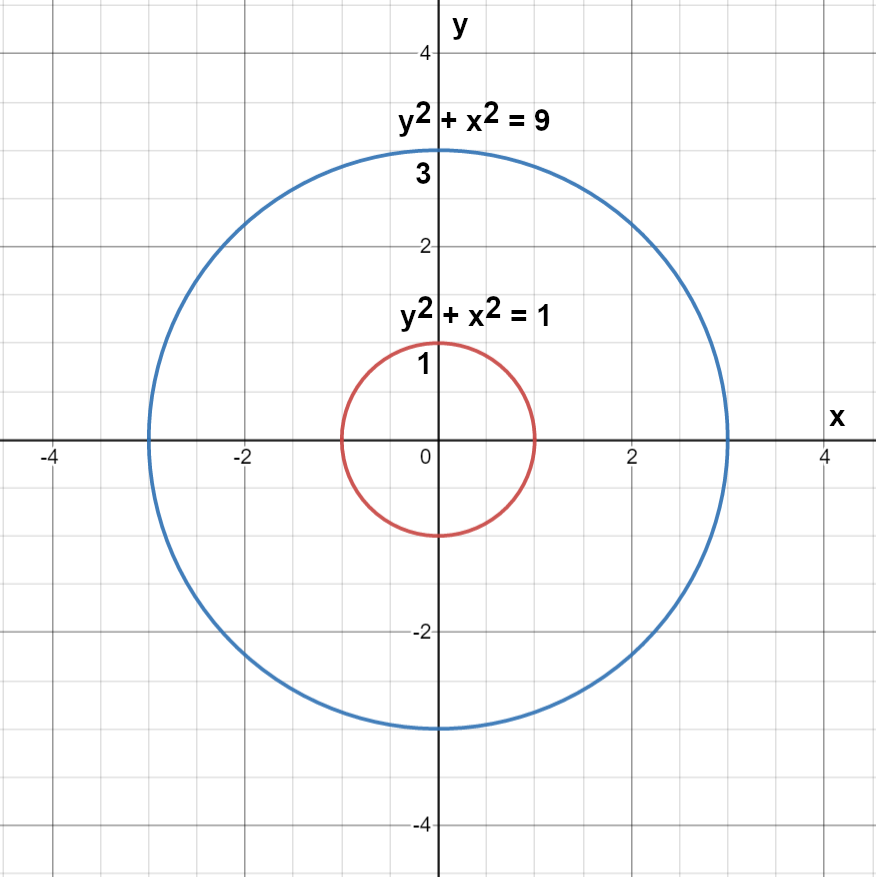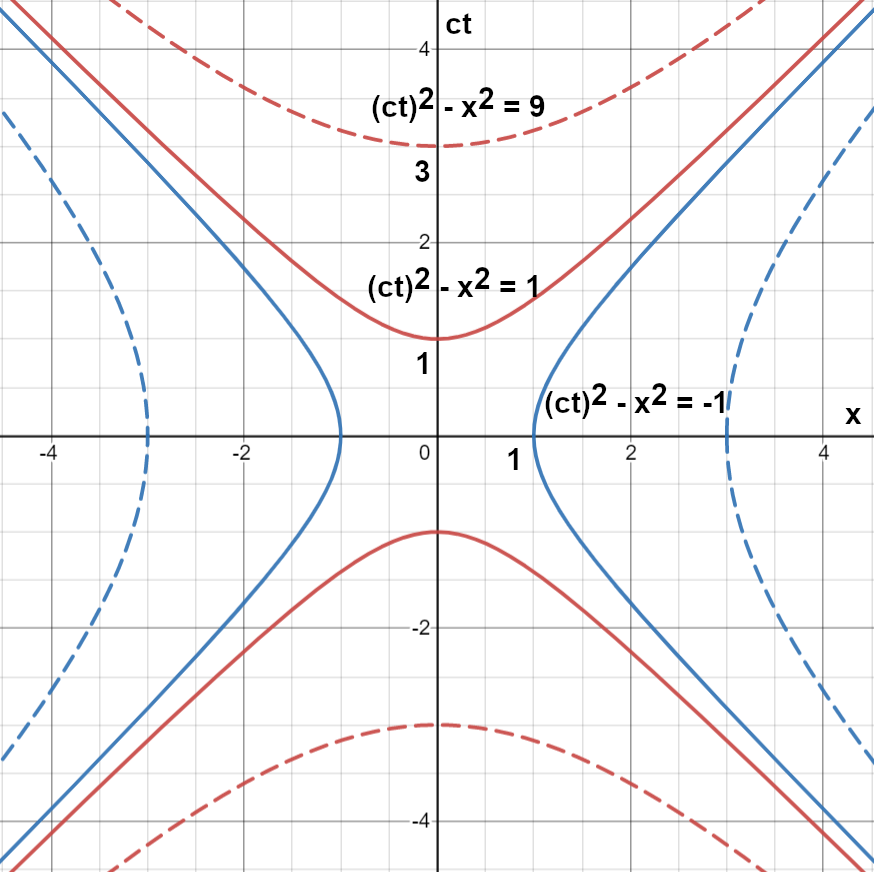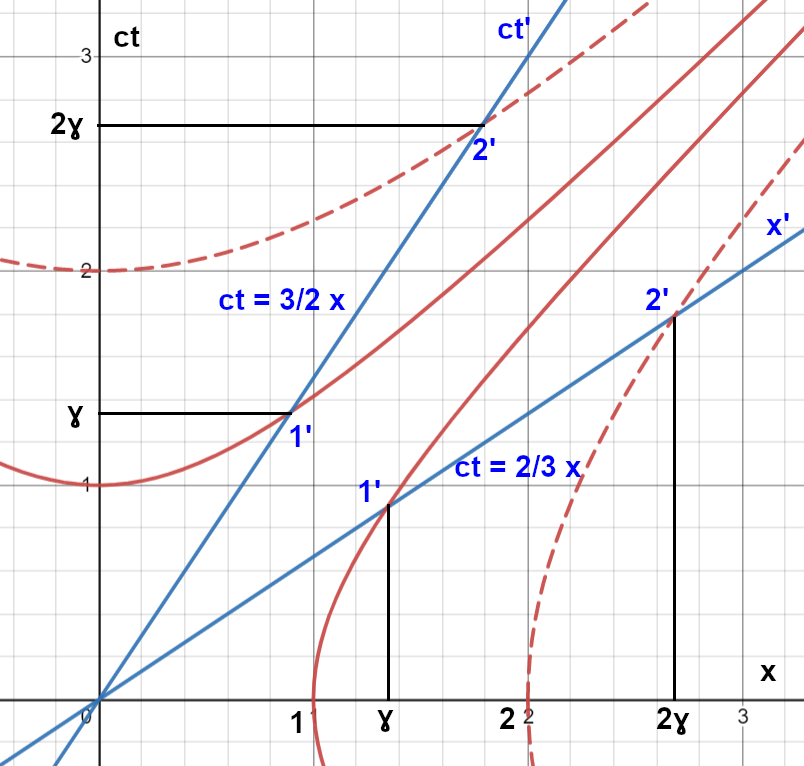Special Relativity 2: Spacetime
Topics
Recap: Lorentz transformations
Let us recap the Lorentz transformation that we derived in the introductory article.
Consider two inertial systems $S$ and $S'$ moving with relative speed $v$ along the parallel axes $x$ and $x'$. The Lorentz transformation relates the coordinates $(x, t)$ in $S$ to $(x', t')$ in $S'$: $$\begin{align} c t' & = \gamma \left( c t - \frac{v}{c} x \right) \\ \tag{1} x' & = \gamma \left( - \frac{v}{c} c t + x \right) \end{align}$$
The inverse transformation is obtained by solving for $ct', x'$ or more easily by subtituting $-v$ for $v$: $$\begin{align} c t & = \gamma \left( c t' + \frac{v}{c} x' \right) \\ \tag{2} x & = \gamma \left( \frac{v}{c} c t' + x' \right) \end{align}$$
Spacetime Diagrams
Spacetime diagrams, developed by the German mathematician Hermann Minkowski (1864 - 1909), are very useful to illustrate the physics of relativity. In a fixed inertial frame $S$, we draw one direction of space $x$ along the horizontal axis and the scaled time $c t$ on the vertical axis.
/physics/en/special-relativity/img/spacetime/The spacetime diagrams illustrate the movement along one direction - the x-axis. In the diagram above the light rays that travel "horizonatlly" along the x-axis in a space-diagram travel along "diagonal" trajectories in the spacetime diagram because also the time axis is represented.
A particle moving with velocity $u$ along the x-axis traces out a curve called a worldline in the spacetime. The slope is greater than 45°: $$ \tan(\beta) = \frac{ct}{ut} = \frac{c}{u} \gt 1 $$
Points in the spacetime are called events. Their coordinates are $(ct, x)$, respectively $(ct, x, y, z)$.
We can also draw the axes corresponding to an inertial frame $S'$ moving with relative velocity $v$ with respect to $S$ (blue axes):
We also included a system $S''$ moving with velocity $-v$ with respect to $S$ (magenta color).
The ct'-axis corresponds to $x' = 0$ and is given by $x = v t$, i.e. $$ ct' \; \text{axis:} \quad ct = \frac{c}{v} x $$ The x'-axis corresponds to $t' = 0$ and is given by $ct = (v/c) x$ (from Lorentz transformation), i.e. $$ x' \; \text{axis:} \quad ct = \frac{v}{c} x $$ It follows that the axes of $S'$ drawn in $S$ are symmetric about the light ray at 45°, i.e. the drawn angles $\alpha$ are really equal, and given by: $$ \tan(\alpha) = \frac{v}{c} \tag{3} $$ Using simple trigonometric identities we obtain a formula for $\cos \alpha$ that we will need later: $$ \cos(\alpha) = \sqrt{\frac{1}{1 + v^2/c^2} } \tag{4} $$
Furthermore, it can also be easily shown using the Lorentz transformation that lines with constant $ct'$ values are parallel to the x'-axis and lines with constant $x'$ values are parallel to the ct'-axis: $$\begin{align} \text{constant } ct': \quad ct & = \frac{v}{c} x + const \\ \text{constant } x': \quad ct & = \frac{c}{v} x + const \end{align}$$
Frame $S'$ drawn in $S$ appears as a skewed coordinate system.
A point in the spacetime is called an event. The event P is represented by $(cT, X)$ in $S$ frame and by $(cT', X')$ in $S'$ frame. The primed and unprimed coordinates are related by the Lorentz transformation.
The diagram shows nicely the relativity of simultaneity. The events A and P happen simultaneusly in $S$ because they have the same $ct = cT$ coordinate. However, A happens after P in $S'$ because its $ct'$ coordinate (the red-line projection) is greater than $cT'$. On the other hand, B and P happen simultaneusly in $S'$ because they have the same $ct' = cT'$ coordinate. B happens before P in $S$ because its $ct$ coordinate is smaller than $cT$. The temporal ordering of events can even be reversed in a moving system. The event D happens before P in $S$ but after P in $S'$.
I will mostly considered only spacetimes with one time axis and one space axis. These are refered as (1+1)-dimensional spacetimes. Notice that the time dimension is kept separately from the space dimension. The general spacetime has (1+3) dimensions.
Distance - the Invariant Interval
In frame $S$, two events $P_1 = (ct_1, x_1)$ and $P_2 = (ct_2, x_2)$ are separated by $\Delta t = t_1 - t_2$ in time and $\Delta x = x_1 - x_2$ in space. The invariant interval $\Delta s^2$ as a measure of the distance between these two points: $$ \Delta s^2 = c^2 \Delta t^2 - \Delta x^2 \tag{5} $$ In 3D geometrical space we would have $$ \Delta s^2 = c^2 \Delta t^2 - ( \Delta x^2 + \Delta y^2 + \Delta z^2 ) $$ The significance of the invariant interval is that it is equal in all reference frames as can easily be verified using the Lorentz transformation. The invariant interval serves as a distance measure in the space-time. Notice, however, that it can be negative. Two events whose separation is $\Delta s^2 \gt 0$ are said to be timelike separated. They are closer together in space than they are in time. Events whose separation is $\Delta s^2 \lt 0$ are said to be spacelike separated. Events with $\Delta s^2 = 0$ are said to be lightlike separated.
Causality
We have seen that simultaneity is relative and temporal ordering of events can differ for different observers dependent on their velocities. This behaviour can be illustrated and explained by meens of the light cone.
The light cone at a point P arises by drawing light rays starting or ending at point P. So, in fact there are two cones: the future light cone and past light cone. In Figure 11 ellipses are drawn to indicate the situation in the general 1+3-dimensional space.
Consider an event Q inside the light cone. Any line of time simultaneity with Q has a slope less than 45° and hence point P is always below this line. It follows that P precedes Q for any observer.
On the other hand the ordering of an event R outside the light cone depends on the velocity of the moving observer. An observer that moves slowly sees the event R following P, because P is below the green line of simultaneity. An observer that moves fast sees the event P following R, because P is above the red line of simultaneity. P and R cannot be temporarily ordered.
The light cone can also be characterized by the distance (as measured by the invariant interval) from P. Points inside the light cone have positive distance from P, while points ouside the light cone have negative distance from P.
Events inside the future light cone of P can be influenced by P. It is possible to transmit information from P to Q at a velocity less or equal $c$. Events inside the past light cone of P can influence P.
Events outside the light cone of P cannot influence P and cannot be influenced by P because information cannot travel faster than light.
Minkowski's Spacetime
Our well-known world obeys the Euclidean geometry - points with equal distances from the origin lie on circles:

In the Minkowski's spacetime points with equal distances from the origin lie on hyperbolas:

Consider now a frame $S'$ moving with a velicity $v$ (for example $v = (2/3) c$) with respect to the stationary frame $S$:

The units on the $S'$ axes (denoted by 1', 2', ...) are given by the intersections of the $S'$ axes with the Minkowski's hyperbolas and are obviously longer than the units on the $S$ axes. We obtain easily for the $S$ coordinates of the point 1' on the ct'-axis: $$\begin{align} 1'(ct, x) & = (\gamma, \frac{v}{c} \gamma) \\ length(0, 1') & = \gamma \sqrt{1 + v^2 / c^2} \end{align}$$
We could have argued also as follows:
The point with the coordinate $(ct', x') = (1, 0)$ in $S'$
is mapped to $(ct, x) = (\gamma, \gamma v / c)$ in $S$.
This means that the length 1 on the ct'-axis in $S'$ is represented
as the Euclidean length $\gamma \sqrt{1 + v^2 / c^2}$ on the
same ct'-axis but drawn in $S$.
The same argument can be applied to the mapping of
units on the x'-axis.
We have derived that the units on the ct'- and x'-axes measured in the diagram are
U-times larger than the units on the ct- and x-axes:
$$\begin{align}
U & := \gamma \sqrt{1 + v^2 / c^2} = \gamma / \cos(\alpha) \tag{6} \\
c t' \text{-unit} & = U \times c t \text{-unit} \\
x' \text{-unit} & = U \times x \text{-unit}
\end{align}$$
Time Dilation and Simultaneity
We will revisit the time effects in the moving frame by means of the Lorentz transformation and the space-time diagram. Consider Alice at rest in the stationary frame $S$ and Bob at rest in the moving frame $S'$.
Alhough Alice is at a constant place $x = 0$ she moves in time along the ct-axis. The points $P_0(ct_0, 0), P_1(ct_1, 0), P_2(ct_2, 0)$ are her positions in the spacetime. Bob is at the constant place $x' = 0$ in $S'$ so he moves at the ct'-axis. His worldline in $S$ is $ct = (v/c) x$.
The horizontal dashed line through $P_1$ represents the world perceived by Alice at the time $t_1$. Bob is somewhere in this world. Because he is on ct'-line he must be at the point $P'_1$. This point has the coordinates $(ct_1, v t_1)$ in $S$ and the coordinates $(ct'_1, 0)$ in $S'$. From Lorentz transformation we know that that $t'_1 = t_1 / \gamma$. Alice's sees the time $t_1$ on her watch but the shorter time $t'_1 = t_1 / \gamma$ on Bob's watch. Bob's watch is delayed with respect to Alice's watch. Bob also sees $t'_1 = t_1 / \gamma$ on his watch.
We can derive the time relation also geometrically from the spacetime diagram. The length from the origin to $P'_1$ is $$\begin{align} c t'_1 & = |OP'_1| = |OP_1| / \cos(\alpha) = c t_1 \gamma / U \quad \text{in ct-units} \\ & = c t_1 / \gamma \quad \text{in ct'-units} \end{align}$$
The events $P_1$ and $P'_1$ are simultaneus from Alice's perspective because they lie an a line parallel to the x-axis. They are not simultaneus from Bob's perspective because for him the events simultaneus with $P'_1$ lie an a line parallel to the x'-axis. So, for him the event $P_0$ is simultaneus with $P'_1$. Bob is at the point $P'_1$ and sees Alice at the point $P_0$. The point $P_0$ has coordinates $(ct_0, 0)$ in $S$ and $(ct'_1, x'_0)$ in $S'$. The relation between these coordinates is given by the Lorenz transformation, so the equation for the time: $$ c t'_1= \gamma \left( c t_0 - \frac{v}{c} x_0 \right) = \gamma c t_0 $$ so $$ c t_0= c t'_1 / \gamma = c t_1 / \gamma^2 $$ as was expected because of the time dilation. In Bob's perspective, he is at rest at the the origin of his frame and Alice moves with the velocity $v$ away from him. So he perceives Alice's clock to be slowed down by the factor $\gamma$.
The fact that the time passes differently in moving frames is rather difficult to understand because it contradicts our perception of a unique global time. Let us restate the time dilation in other words. Alice und Bob have each a clock and the clocks run at the same pace for each of them. At a particular instant Alice checks the time and sees $t_1$ at her clock and $t_1 / \gamma$ at Bob's clock. Bob has indeed $t'_1 = t_1 / \gamma$ on his clock. Bob and his clock are delayed with respect to Alice. When Bob looks at Alice's clock he sees the time $t_0 = $t'_1 / \gamma = $t_1 / \gamma^2$ at her clock. For Bob, Alice is not at the point $P_1$ but at at the point $P_0$. Alice and her clock are delayed with respect to Bob. (Bob will be at time $t_1$ later, in fact when he will be at the point $P'_2$).
To make the discussion complete, let us find the point $P'_2$ where Bob's clock shows the time $t_1$. Since $t_1 = t'_2 / \gamma$ we have $P'_2(ct'_2, x'_2) = (\gamma c t_1, 0)$ in $S'$. The coordinates of the same point in $S$ are found using the Lorentz transformation: $P'_2(ct_2, x_2) = (\gamma c t'_2, \gamma v t'_2)$. The point $P_2$ is then $P_2(ct_2, 0) = (\gamma c t'_2, 0)$ in $S$.
Twin Paradox
Alice and Bob are twins. One day Bob leaves Alice to visit the planet P. He travels at velocity $v$ close to light speed. After he reaches P he turns and flies back to Earth. Alice knows that he was travelling at a high speed, so his clock was slower. She expects that he will be younger than herself after his return. Bob sees the situation differently. He was at rest inside his spaceship and for him Alice was moving with respect to him, so he expects Alice aged less than himself at the reunion. These controversial situation is called the twin paradox.
We will now resolve the apparent paradox and show that it is not a paradox at all. Alice will be older than Bob at his return.
When Alice is at B at the time $T$ she observes Bob reaching the planet P. Bob's clock shows the time $T / \gamma$ and he sees Alice at A and her's clock showing $T / \gamma^2$ The line PA is the line of simultaneity for Bob at P.
Now, Bob makes a sharp turn by 180° and moves back at velocity $-v$ with respect to Alice. He is now fixed in the violet frame $S''$. After the turn he sees Alice suddenly at the point C which lies at the new line of simultaneity PC for Bob. So, Bob sees Alice to age suddenly from A to C. From symmetry reasons, the coordinate of C is $(2 T - T / \gamma^2)$.
At the point D, when Alice welcomes Bob back, she aged $2 T$ and he aged only $2 T / \gamma$.
Length contraction
Consider a rod of length $L_0$ that is at rest in a Bob's frame $S'$. In the spacetime, the back end of the rod moves along the ct'-axis:
Now, assume that the Bob's frame $S'$ moves with respect to a stationary Alice's frame $S$ with the velocity $v$:
When Alice measures the length of the moving rod she has to locate the endpoints of the rod in her frame at the same instant of time in her frame. So, she measures the length as the distance $L = dist(P_1, Q_2)$. Let us compute this distance.
The back of the rod moves on the line $ct = (c/v) x$ while the front of the rod moves on the line $$ ct = (c/v) (x - L). $$ This line passes through the point $P_2$. The point $P_2$ has the coordinates $(0, L_0)$ in Bob's $S'$ frame. Using the Lorentz transformation we get the coordinates of $P_2$ in Alice's frame $S$ as $(\gamma (v/c) L_0, \gamma L_0)$. Substituing these coordinates into the line equation we get $$ \gamma \frac{v}{c} L_0 = \frac{c}{v} (\gamma L_0 - L) $$ Solving for $L$ we get $$ L = L_0 / \gamma $$ as was expected. Alice observes the length of the moving rod shortened by the factor $\gamma$.
Ladder and barn paradox
Alice obviously cannot put a ladder of length $2L$ into a barn of length $L$. So, she asks Bob to run fast with the ladder such that $\gamma \gt 2$. The length of the ladder will shrink to $2L / \gamma \lt L$ and the ladder will fit into the barn.
Bob does not agree with this proposal. When he will run with the ladder, the ladder will be at rest with respect to him and stays $2L$ long. But the barn will move relatively to him such its size will shrink to $L / \gamma$. The situation will get much worse.
Who is right? We assume (wrongly): Since there is only one 'reality' one of the observers must be wrong. Let us have a look at the spacetime diagram:
When Bob's ladder hits the wall of the barn at the point P he sees the end of the ladder at the point QB that is for him simultaneous with P. According to him the ladder is surely not in the barn, that is represented by a pink color.
When Alice sees the ladder hittings the wall of the barn at the point P he sees the end of the ladder at the point QA that is for her simultaneous with P. According to her the ladder is in the barn.
Both observers are right and our assumption about 'one reality' is wrong. The situation involves several events whose simultaneity is observed differently by moving observers. So, the "ladder and barn paradox" is not a contradiction to the theory of relativity and does not need a "resolution". It is an illustration of the relativity of simultaneity.
Links
- Mechanics and Relativity PDF-book by Timon Idema
- Lectures on Dynamics and Relativity (David Tong, University of Cambridge)
- Special relativity (University Physics Volume 3)
- Special relativity (Video course by Brian Greene at World Science Foundation)
- Lorentz Transformation (Shankar, Open Yales courses, 2006)
- Spacetime (Wikipedia)
- Length contraction (Wikipedia)
- University Physics (PDF, Volume 3)
- Ladder paradox (Wikipedia)
